Suzhou Story (3)--Neighborhood Prosperous by Water
D1:
Walking method: High-speed rail-Nanjing to Suzhou; subway + bus + walking
Tour routes: Master of Nets Garden-Shiquan Street-Keyuan-Canglang Pavilion-Shantang Street-Hanshan Temple, Fengqiao
D2:
Walking method: subway + bus + walking
Tour routes: Suzhou University Headquarters-Eastern Campus-Xiangmen-Qiyuan-Pingjiang Road Historical District-Guanqian Street
D3:
Walking method: subway + bus + walking; high-speed rail-Suzhou to Nanjing
Tour routes: Xi'an Jiaotong University Liverpool-Nanjing University Research Institute-Renmin University Suzhou Campus-Xietang Old Street-Jinji Lake Lakeside Park
Although the three-day trip is short, it is rich in content. In order to better present it, I divided our "Suzhou Story" into three chapters to express it: "Suzhou Gardens that Must Visit","Different Universities" and This article "A Neighborhood Prosperous by Water".
Suzhou is a beautiful water city. It is a "water town"."People are sleeping on the river"."Oriental Venice" is the concept of Suzhou City. Dating back to the period of Emperor Yang of the Sui Dynasty, the Grand Canal began to be dug on a large scale with Yangzhou as the center. On the basis of Hangou, the north-south expansion and connection are carried out. Suzhou's Gucheng River is an integral part of the Grand Canal. The Beijing-Hangzhou Grand Canal has flowed for thousands of years, nourishing the land on both sides of the river, nourishing the people along the river, and prospering the towns along the river. Suzhou has become a paradise where thousands of merchants gather because of the canal. Suzhou's ancient canals surround the beautiful ancient city of Suzhou like a jade belt. Along the way, there are scenic spots with historical stories such as Suzhou Ancient City Wall Ruins, Xiangmen, Panmen, Guxumen, and Mudu Bridge. In addition to the thousand-year-old ancient city surrounded by canal water, Suzhou also has two major lakes, Dushu Lake and Jinji Lake, located in the modern Suzhou Industrial Park. Dushu Lake was formed by a major earthquake during the Song Dynasty. It has beautiful scenery and clear lake water. It is one of the largest freshwater lakes in Suzhou. On the east side of Dushu Lake is now the Dushu Lake Science and Education Innovation Zone, which gathers well-known universities and research institutes at home and abroad, including Xi'an Jiaotong-Liverpool University, Dushu Lake Campus of Suzhou University, Suzhou Research Institute of Xi'an Jiaotong University, Suzhou Research Institute of Nanjing University, Suzhou Campus of Renmin University of China... I have shown all of these in "Different Universities". Another beautiful lake located in the Suzhou Park, Jinji Lake, is smaller than Dushu Lake in area, so it more embodies its carefully arranged five major functional areas: cultural exhibition area, fashion shopping area, leisure and food area, urban sightseeing area, and central waterscape area. Let's go and see the neighborhoods in Suzhou that are booming because of water!
one. shantang Street
Suzhou has many streets and alleys, and the "No. 1 Street in Suzhou" is Shantang Street. It was already night when we took the subway from Canglang Pavilion to Shantang Street.
After leaving the subway station, you will find Xinmin Bridge a few steps away. The Songhelou at the bridge is a time-honored restaurant that is still open on the 30th of the Chinese New Year. It is crowded. Nowadays, people can enjoy life, and more and more people choose to enjoy reunion dinners in restaurants.
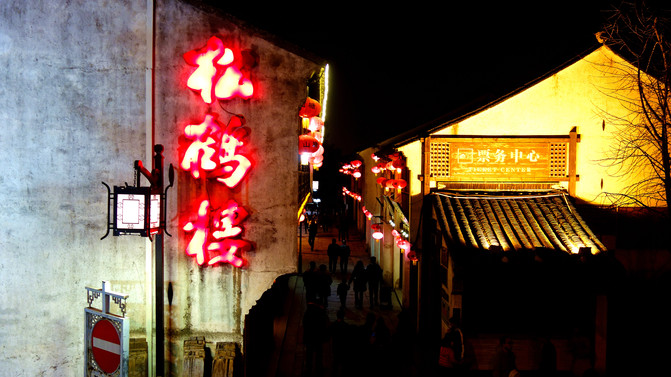
Standing on Xinmin Bridge and looking at Shantang Street, this water alley with a history of more than 1,000 years. The street is built against the Shantang River, where boats flow and houses have stone steps along the river. From this perspective, Shantang Street is a river embankment.

Shantang Street meets with the canal, which greatly facilitates local water transportation and makes Shantang Street a prosperous downtown in history.

Branches, ships parked quietly under the light and shadow.

Standing by the river embankment and looking at Xinmin Bridge.

The pier of Shantang Street, where you can take a cruise ship and visit Shantang Street at night.

Shantang Street is connected to Suzhou's prosperous commercial district at one end and to Tiger Hill at the other end.

Now the southeastern section of Shantang Street has become a tourist attraction and has been created to shine brightly.

The old buildings along the river are well preserved, and the old buildings are either time-honored items or time-honored traditions. Kunqu Opera and Pingtan with local characteristics celebrate the New Year in the old house.


A time-honored pastry shop.

Attractive butcher shop

This year is their year.

The prosperity of Shantang Street has been at its peak since the Tang Dynasty. There are many shops and clubs here. Many businesses on the New Year's Eve are closed, and only a few are still operating. However, all this did not affect the flow of people lounging on Shantang Street. Most of them come to Shantang Street with us for a walk and admire the old streets and houses. Feel the blue bricks and stones here, the uneven bluestone slabs, the towers and stages around you. Listening to the sound of flowing water in the Shantang River here, you will probably be satisfied!



Charming and moving night view of mountain ponds.

The ancient walls and bricks on the street look green with the polishing of time.


The pattern of Shantang Street is a typical representative of Suzhou's old streets, including ancient streets, small bridges, flowing water, old houses and the most representative city life. Two rows of red lanterns light up the flowing Jiangnan on New Year's Eve, and the black tiles and pink walls release the poetic and picturesque meaning of the water town to the extreme.

The modern life of ancient city people still maintains the tradition of life in the water town. The residential houses built next to the water surface in the water town are called "river houses". These people all have diamond-grid doors and windows near the water, which not only allows light but also takes scenery.

Sometimes when you turn a corner, you will be pleasantly surprised by the narrow river beside the path. The red lanterns on one side, the small light strips on the other side outline the outline and emit a light yellow light, the light ink tree shadows overlap on the deep-ink river, and the gray-white house walls beside the river are as quiet as a pure and beautiful ink painting. In this corner where there are few tourists, there is no noise and no noise. I stay quietly in the painting, and it is beautiful to be meditative.

Walk southeast until you come to the Imperial Stele Pavilion.

There is an imperial stele pavilion at the street entrance, and under the pavilion is a stele of "Searching for Victory in a Mountain Pond".
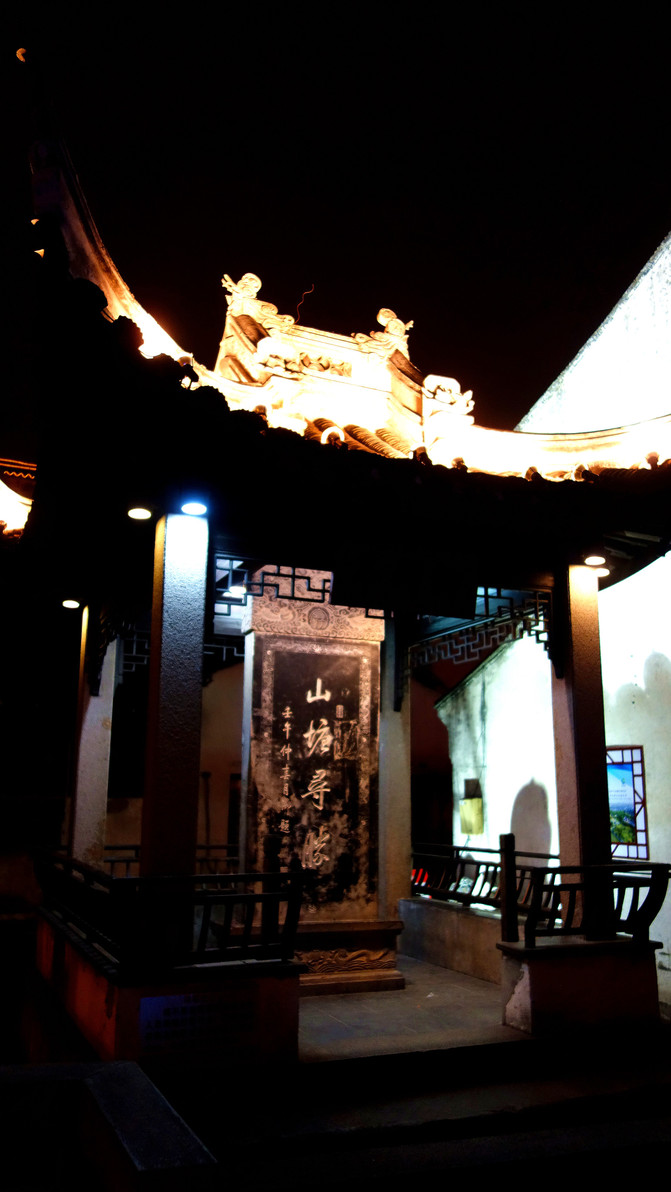
Look at the well-preserved neighborhood, with white walls and black tiles and wooden doors, shining brightly under the night lights and moonlight.

The straight mountain pond bridge spans the river

The two-story building on the street is the online celebrity store-Maokong Bookstore.

The "Ancestor of Shantang" is the "Tang Shaofu Baigong Temple". Legend has it that Shantang Street was dug by Bai Juyi during his tenure as an official in Suzhou.

Duseng Bridge, the starting point of the southeast of Shantang Street, spans the river.

The long Shantang Street starts from Changmen Duseng Bridge in the east and ends at Wangshan Bridge in the west. It is accompanied by water and land and is about seven miles long, so it is commonly known as "Qilishantang to Huqiu".

It is said that the first half of Shantang Street, that is, the southeastern section we are rushing through today, is for tourists, and the second half of Shantang is for Suzhou people to remember. Although today is New Year's Eve, it is still crowded here, and crowded places always make people impetuous. I will definitely come back to Shantang. On a day when there are few people and the wind is clear, I will have a good and complete experience of the complete Shantang from front to back, its prosperity and market.

two. Pingjiang Road Historical District
All books or websites introducing Suzhou tourism mention Pingjiang Road in the historical district. This is related to the fact that various cities now use the old streets and alleys in the city to create a place suitable for modern people to eat, play and enjoy. However, how to build a neighborhood that is popular with modern people while retaining traditional historical features is a learning.
Pingjiang Road was called "Shiquanli" in ancient times. For more than 800 years, the river shape and street direction here have retained the water town pattern of "water and land parallel, river and street adjacent". Someone said that you will never understand Suzhou if you don't come to Pingjiang Road. Therefore, Pingjiang Road is a must-visit place in addition to the gardens of Suzhou.
On this day, we went from the campus of Soochow University to the Xiangmen City Wall and visited the Yiyuan. The eastern section of Daxinqiao Lane comes out of Jianyuan. The alley is not wide, four meters long, Daxinqiao Lane, which is more than 700 meters long, is an east-west alley. The west end of the alley connects to the middle section of Pingjiang Road.
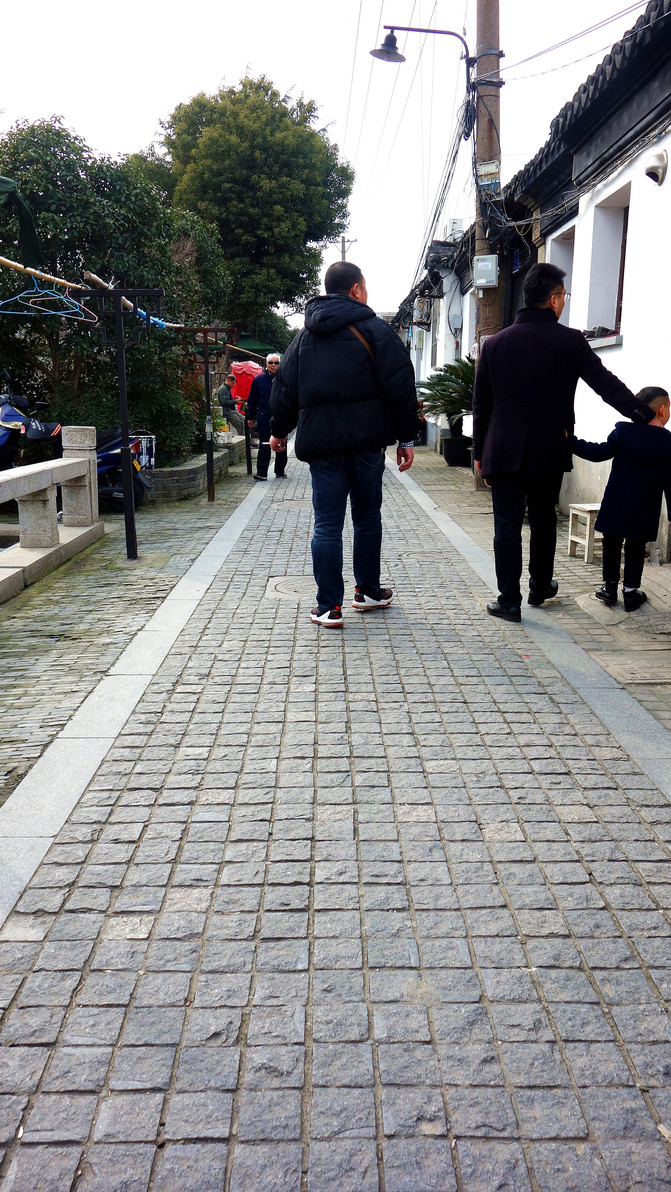
Daxinqiao Lane runs parallel to Xinqiao River, a tributary of the Pingjiang River. Almost every lane here is accompanied by a corresponding river, and Xinqiao Lane is no exception.

There are not many tourists in Daxinqiao Lane. Walking on the long stone path, we can see old houses with scattered heights and heights on one side, and the flowing river on one side allows us to see the living environment of Suzhou people for hundreds of years. Original appearance.

Daxinqiao Lane still retains a strong atmosphere of life and traditional folk customs.

On one side of the alley is a high wall sandwiched by winding streets and alleys, which has a somewhat winding path leading to a secluded scene. How many private gardens are hidden inside these high walls?

Ancient houses are inconspicuous dotted in the alleys. Duyoutang Yuan Zhai, No. 28 Daxinqiao Lane. The dark brown door and two copper lion head doorrings tell the unusual stories of the past here in a simple atmosphere.

Pang Zhai, built during the Guangxu period of the Qing Dynasty, is now Suzhou Xiaoya International Youth Hostel.

The narrow alley leading to the private houses is only two shoulders wide, making it more tranquil. The depths of the alley should be the homes of ordinary people.

Passing by a residential building in the late sun is Guo Shaoyu's former residence, No. 12.13.20, Daxinqiao Lane.

Moke Garden at No. 10 Daxinqiao Lane is a deep courtyard integrating Suzhou gardens and hotels. I may rest here next time I come. It's a wonderful experience to fall asleep here with the sound of gurgling water. If Kunqu Opera happens to be here, the performance of Pingtan will be even more perfect.

In an alley, you can see Suzhou classical elements such as flying eaves and crooked corners, stone rockery, straight curved small bridges, octagonal pavilions, various flower windows, etc. The manic roar of a dog could be heard far away. It turned out that it was the angry roar of this huge dog on the other side of the river.

The objects it roared were the two puppies playing affectionately in the alley. The big dog on the other end of the river bank left the river bank time and time again, roaring and sprinting. Its angry momentum made me suspect that it would leap across the river regardless. But in the end, it still rationally stopped by the stone bench, its two front paws resting on the long stone bench, its body straight, and it barked at the two puppies with all its strength. This is the first time I have seen such a scene. I saw a dog so angry and sympathized with the big dog on the other side of the river. It seems that my girlfriend has fallen in love with someone else. The two puppies threw themselves into their own games and ignored them. "Ask what is love in the world"?

Vertical to Pingjiang Road are many narrow alleys. One end of the alleys is connected to the quiet and simple Pingjiang Road, and the other end is connected to the bustling urban streets. Daxinqiao Lane is one of them. It allows me to experience the unique charm of "hidden in the city" formed by the combination of Suzhou gardens and markets. The art of the Qing Dynasty's repair courtyard also requires the completion of fireworks from the world. Only in this way can it be a city with a tune and people's likability.

The west side of Daxinqiao Lane is Pingjiang Road. Here is a map of the current situation of Pingjiang Historical District. From the picture, you can see the streets and alleys in the entire block, and the distribution of rivers is like a "double chessboard". As early as the Southern Song Dynasty, Pingjiang Road was the main road in the eastern half of the city at that time. For more than 800 years, the rivers here have a moat and Pingjiang River vertically, and Xinqiao River horizontally, Liuzhi River, Huxiangzhi River and Xuanqiao River, forming a "two vertical and four horizontal" river network. Therefore, Suzhou is located in a water network, with streets built along the river, parallel to land and water; buildings built next to the water, with alleys and rivers in front of them, thus forming a unique style of "small bridges, flowing water, and people".

In the Pingjiang Road Historical District with small bridges and flowing water, you can appreciate the saying "The beauty of Suzhou is as beautiful as water". Canals, small rivers and folk houses with white walls and black tiles form ink paintings of harmonious Jiangnan water towns.

Along the canal, the residential houses distributed in small rivers preserve the overall style and spatial structure. The Pingjiang River running from north to south is the fourth straight river in the city designed by Wu Zixu in 514 BC in parallel with water and land; the Pingjiang Road accompanying the river is an ancient street connected by small bridges, flowing water, and people.

In the river, small boats passed slowly, and the oars in the water swayed gently along with the blue-and-white cloth woman. The simple song of the woman takes you into the artistic conception of the water town along with the sound of the oars tearing through the river.

Turn right in Daxinqiao Lane and you will enter the now lively Pingjiang Road. I didn't expect Pingjiang Road to be so lively on New Year's Day. In the crowd, you only need to walk passively, and one stop will cause road congestion. The streets and alleys are lined with shops, crowded with tourists, and bustling.
I have to try my best to eliminate the interference of people and see my own self on Pingjiang Road, which is difficult. Judging from the current flow of people, you can imagine that this place has been an important trade center along the canal since ancient times.

There are many shops in the neighborhood, ranging from time-honored brands in Suzhou to traditional shops in front and back. This place can be called "the epitome of old Suzhou."

Today's Pingjiang Road has been protected and renovated as a historical and cultural street, but the main focus is the style of being renovated as old. In addition to the indigenous people in the streets and alleys, the shops along the streets are occupied by young people with literary and artistic feelings. They run creative shops here, bars, clubs, cafes, art institutions, bookstores. However, the appearance is not ostentatious, and it is quietly hidden under the wooden door panels. At first glance, it looks like an ordinary residential house, but you can see some clues from the extremely exquisite carved porch and the artistic face of the door.

There are many flowers and plants placed at the door and window sill of every store. The door and face of every store are dressed with a literary atmosphere, making it a good place to shoot. This company sells original bags, and photos are not allowed in the store, so let's take a picture of the beautiful door face!

The lively Pingjiang Road also retains a large number of old-fashioned houses, and the houses are still houses inhabited by ordinary people. The old house has white walls and blue tiles, wooden grilles and flower windows, and the wood is mostly brown-red or brown-black, light and distinctive. Most of the exterior walls are mottled, but they have images like ink paintings.

Standing on the Zhumajiao Bridge, you can see the road paved with stone slabs and on the revetment, a row of stone railings, stone tables and stone benches dotted between them. Pingjiang River flows quietly along with Pingjiang Road under your feet. Although Pingjiang Road is just a 1606-meter riverside road, it is a classic water alley with a long history in Suzhou.

A long Pingjiang Road carries hundreds of years of history of Suzhou. It has the most characteristic small shops in Suzhou and the most charming stone road.

Pingjiang Road is full of people, so you don't have to think about walking passively along the people. This hexagonal wooden building has doors and windows on the second floor that are lightly opened. This is a characteristic concept bookstore-Maokong Bookstore.

Address: No. 25, Pingjiang Road, Gusu District, Suzhou City, Jiangsu Province
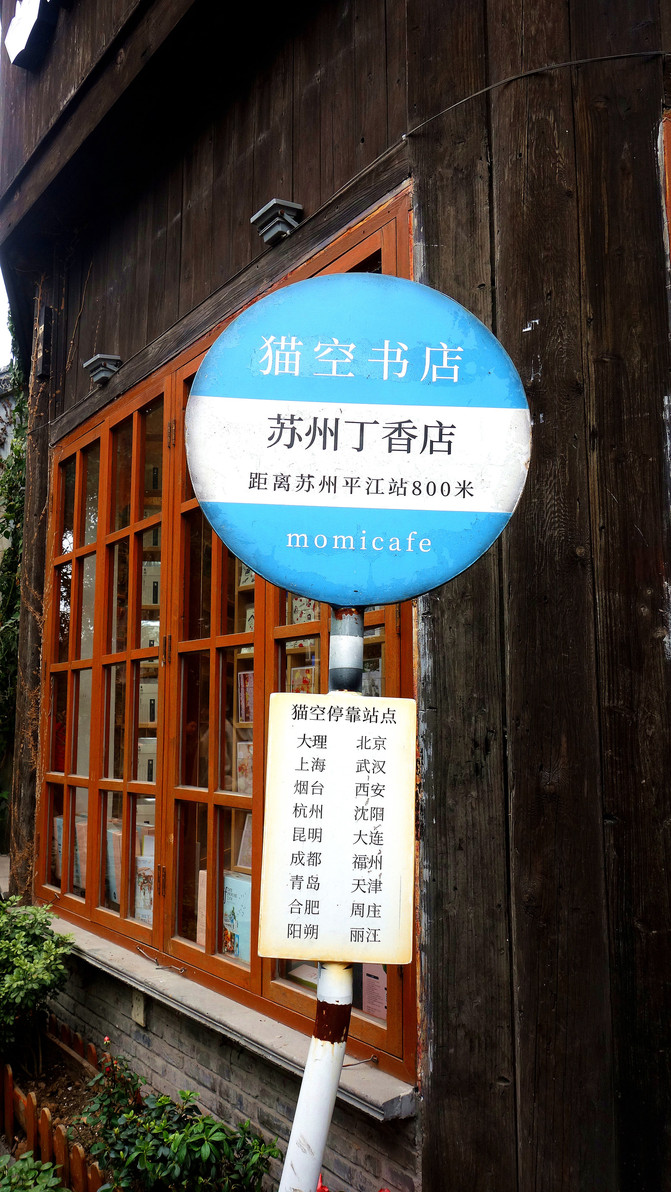
As soon as you enter the door, you feel like you have become a cute sister with various shades of powder. Take photos here and play with small objects. Most of the sundries here are interesting, including water cups with cats, water cups with pink pigs, wooden bookmarks, colored tape, transparent folders of large and small pink... There are some cute things in your hands and look at it for a long time before you figure out its actual function.

The things we manage here are all things that I like in my heart. They are as small as a card, a book, as big as a bag, and a book, all have cute qualities.

Books, postcards, various notebooks, stationery, clothes, bags, as well as coffee, desserts, were dazzling. You can go shopping, take photos or just stroll around and sit.


Following these famous words under my feet, I came to the second floor.

There are two areas upstairs
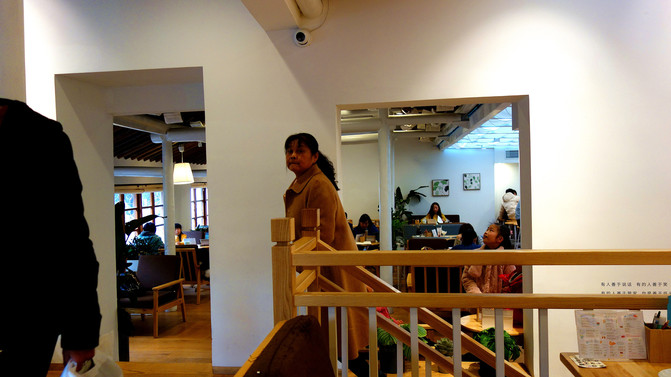
On the left hand side of the stairs is the book display and sales area.

Bookstores record the expression of the city. A city's attitude towards paper books can be seen from the city's attitude towards culture.


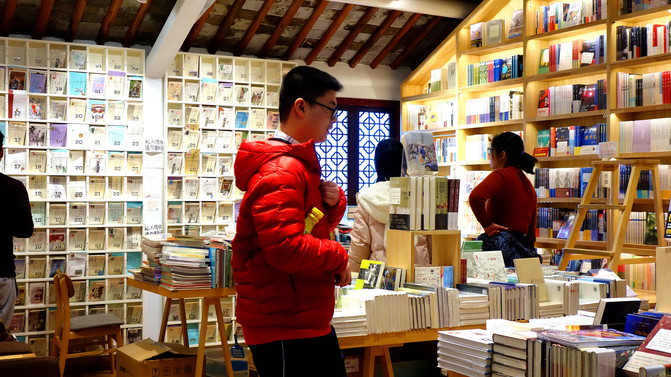
This is a bookstore and a postcard themed shop. It sells special postcards and hand-painted maps.

There is a whole wall of postcards under the herringbone eaves called "Send to the Future". The wall is full of unique postcards, each one is unique and creative.
This place carries everyone's blessings and dreams. You can pick a postcard you like here, write soft words, and send it to your loved ones and those you care about! You can also write to yourself to make your day full of surprises.

Books also put on wings and fly on the roof. What a romantic idea.

There is a large space on the second floor that is a seating area. Here, there is a person walking alone, ordering a cup of coffee, a dessert, and a book, and sitting for most of the day; there are also couples accompanying them, lowering their heads and talking secretly; there are also three or five friends gathering together to laugh and laugh about life, and let the time go by.

If it was a quiet day, I could not go anywhere, just hold a cup of coffee here and look at the bluestone slabs on Pingjiang Road, and at the woman wearing cheongsam who might occasionally pass by...

There are countless small alleys on Pingjiang Road. Once you turn in, you will be far away from the hustle and bustle.

This 360-meter-long alley has a nice name-Lilac Lane

I traveled through the streets and alleys all the way, leaving the noisy flow of people on Pingjiang Road, and the tranquility of the narrow alleys made me breathe a sigh of relief. The more you walk into a quiet place, the more tranquility you feel.

The noise of Pingjiang Road makes people impetuous, but because it is my first time here, I still want to have a good look at Pingjiang Road, even if it is a little far from my imagination. I returned from the quiet alley to Main Street. The main street along the river with small bridges and flowing water has a completely new feeling. There are many old houses with blue tiles, white walls, and red doors and windows along Pingjiang Road. However, most of the old houses are now wrapped in modern packaging, with delicious shops next to each other, including coffee, tea houses, bars, national costumes, piano art...

Blue is a color that I can't resist. Among the blue-gray colors lined up on Pingjiang Road, the blue doors and windows are particularly eye-catching. Bulan Rabbit's plant estate, sweet tea tea, exquisite tea sets, and exquisite gift boxes are all petty bourgeoisie tunes.

Yunhuashili, a poetic name. The things sold are more creative, packaging the elements of the pastry book. I remember one of the things I often said when I was a child to cope with exams was,"I can't wait to eat the book." Now I can really do it.

Time Code creative groceries in the old house. From the cute window layout to the dazzling array of gadgets in the store, they all bring memories of our childhood.



Looking at these little cute people, I feel that I have returned to my girlhood.

These handsome and cute little guys can be seen everywhere on Pingjiang Road.

When you meet water, you must meet the bridge. I have met several bridges from the other end of Jianyuan. The Pingjiang Road block is densely covered with alleys, with small bridges connected to each other. There are more than ten bridges. The bridges are all stone bridges, of various shapes, with simplicity and exquisiteness. The small bridge carries flowing memories, and the small bridge talks about the ancient past. This arch-shaped single-hole ancient stone bridge-Huxiang Bridge is one of the seven remaining ancient stone arch bridges in the ancient city of Suzhou. It is an ancient bridge with original flavor.

Sitting by the river beside the bridge, there are rows of houses with green tiles and white walls stacked on top of each other. The canal under your feet has been flowing quietly for thousands of years. The life of Suzhou people is unfolding here in a simple and exquisite manner.

Imagine the boats and people coming and going in front of one water terminal after another. They go from here to the outside world and bring the outside world back here. Thousands of stories have happened here, either happy or sad... This is a living Jiangnan Urban Architecture Museum, which records the life of a city through the ages.

There is a small pavilion at the entrance of the alley, and a wisteria shed is built on the small pavilion. On the other side of the river, there is a wooden beam and tile roof, living next to the river, with a herringbone roof and a small flying corner... The walls of the houses are already mottled. At a glance, you can see a typical Jiangnan residential pattern that is ancient. The craftsmen in Jiangnan have delicate minds, and even the daily houses are full of art. The river is gentle, and houses, corridors, pavilions, small bridges, flowers and trees are hidden from each other by the scenery, making it always picturesque.

"Controlled Protection Building", the former site of Wang's Yizhuang,"Shangaluo", was built in the 22nd year of Daoguang in the Qing Dynasty. It is the only controlled and protected building on Pingjiang Road.

Pingjiang Road is like this. New things, trendy people overlap with old times and old shadows, weaving their own story.

The canal water flowing into the city under our feet is connected to the Suzhou water system. Four old canals and seven heritage sites constitute a heritage system centered on the ancient city.

Pingjiang Road on New Year's Day was crowded with people. It was not the Pingjiang Road I imagined. I began to naively think that no matter how many people flow, the stone road under my feet and the river water slowly flowing along the stone road flow along the stone road flow along its own accord along the trajectory of time. I am the self who can try my best to eliminate interference and want to see it. But I didn't do it. Some artistic conception is a psychological framework, but it is difficult to achieve it without the cooperation of the environment and the psychological framework. This is not a place to be quiet. This is not the Pingjiang Road I imagined. I left as if I were running away, and at the same time told myself that I would be here again soon. Find an ordinary day and stay here for a few days. A good place is worth spending your time waiting for. I am here to find the real Pingjiang Road. I believe that Pingjiang Road and the many narrow streets and alleys vertically connected to Pingjiang Road, such as Shilin Temple Lane, Chuanfang Lane, Donghuqiao Lane, Caohuxu Lane, Daxinqiao Lane, Weidao Guanqian, Zhongzhangjia Lane, Daru Lane, Xiaojia Lane, Niujia Lane, etc., each name may have a long story behind it. I want to find the real Pingjiang Road.
three. guanqian Street
Every city will have an ancient street with a long history and a familiar modernist street. Guanqian Street is a representative street in the center of Suzhou City. In fact, it has a long history. A street in front of Xuanmiao Temple that originated in the Song Dynasty was renamed Guanqian Street in the Yuan Dynasty. The archway standing tall on the square is a symbol of history. There was no separate plan here, but because of the crowded flow of people on Pingjiang Road, we left in a hurry, we had time to come to this famous street in Suzhou where modernization and history blend.

Both the architecture and business styles on Guanqian Street are more modern.

The restaurants on Guanqian Street are also crowded. I didn't want to eat in a noisy environment, so I chose Haagen Dazs for some dessert.


Four. Xietang Old Street--Garden-style imitation old and new neighborhood
Address: Suzhou Industrial Park, Suzhou City, Jiangsu Province
I can't wait to get close to the two most famous neighborhoods in Suzhou-Shantang Street and Pingjiang Road. To be honest, I am a little disappointed. What is disappointed is not the nature of the street, but the fact that many tourists have completely covered the true nature of the street and cannot find its original taste. I really want to find a street in Suzhou where I belong to and walk quietly. After some searching on the Internet, we discovered Xietang Old Street. On this day, we traveled from Dushu Lake Higher Education District and took the bus all the way north to Xietang Old Street on the shores of Jinji Lake. The water of Jinji Lake not far from the west side of the old street runs eastward along this Xietang River, building a historical waterway connection between counties.

The clear and faint Xietang River divides Xietang Town into two. The south side of the river is called Tangnan, and the north side of the river is called Tangbei. River and street accompany. The current Old Street is an old street block rebuilt on the original site of Xietang Town, which has a history of more than 760 years. It can be said to be a copy of the old and new street block!

Across the Xietang River is a Weimin Bridge, connecting Tangnan and Tangnan to the north.

The "Weimin Bridge" was built in 1930 and was built with funds raised by Xietang merchants at that time. The bridge was built to greatly facilitate people on the south bank of the Xietang River to come to the old street for shopping, so the old street prospered. Xietang Old Street refers to an old street in Tangbei (left side in the picture). The street runs east-west and is built along the Xietang River. On both sides of the street, most of them are two-story Jiangnan buildings with white walls, blue tiles and red window mullions. Now they are used to make shops. These shops with south-facing facade located on the north side of the street are called Shangjie. Correspondingly, there are also some north-facing shops along the river on the south side of the street (on the right side of the picture), called Lower Street. In addition to a few scattered storefronts and houses on the lower street, there are also characteristic buildings of Jiangnan water town with pavilions and winding paths. Now both the bridge and the street are renovated.
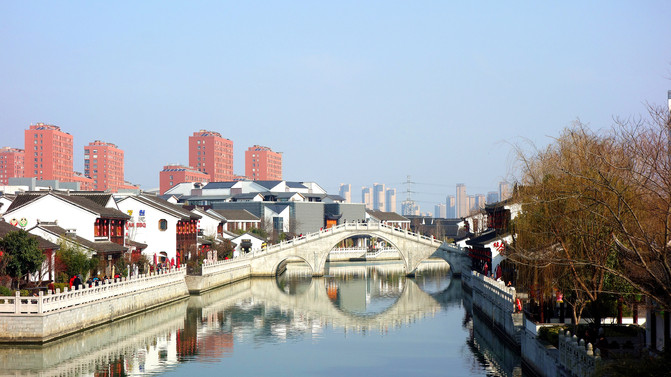
Today's sky is high and crisp, and the reflection of the Xietang River under the blue sky and blue clouds is clear, like a watercolor oil painting.

Stroll along the shed corridor down the street. Shed corridors are also a feature of Jiangnan, and their advantages will be fully demonstrated in rainy seasons.


Walking through this landscaped neighborhood, you don't have to rush along with the people. Slowing down is it like going back in time, like being in Suzhou City hundreds of years ago? Or do you want to feel the perfect combination of modernity and classics?

The buildings along the street are mainly on the first and second floors, with slope roof style, white walls, blue tiles and red window mullions. There are stairs along the street that can be planted into the river. It is the original appearance of the houses in the Jiangnan water town.

But this old street with a history of more than 700 years is not what I imagined. Everything is brand new. The white walls, courtyards, flowered windows, and stone arch bridges are clean and pure. It is hard to imagine what she looked like before the renovation. But from the style and scale, can you imagine the simple and prosperous scene here hundreds of years ago when merchants gathered, shops lined up, and shops gathered here?

The street is paved with bluestone bricks, with shops connected and facades facing each other. This place is not as famous as Shantang Street or Pingjiang Road. Because of this, there are relatively few tourists here. Because there are few people, you can walk slowly and stroll around here, feel and taste the unique humanities of Jiangnan here, and naturally taste the faint flavor of Suzhou that I want to find.
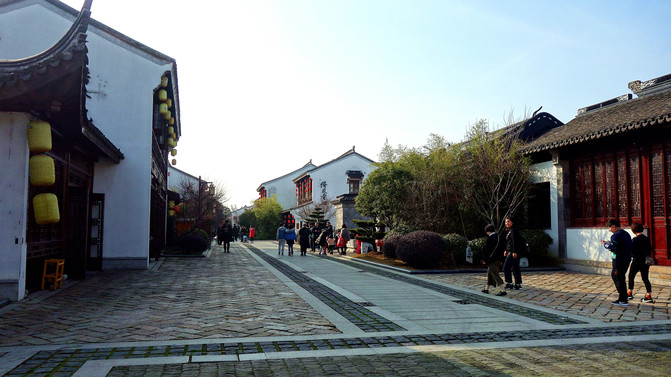
On the bluestone slab arch bridge "Longcang Bridge", this woman dressed as Wang Zhaojun is dressed in a red cloak, wearing a hairpin, and holding a folding fan. She is enjoying this exquisite and fashionable Soviet-style slow life comfortably!

Walking slowly here, you will find the traces of Xietang Old Street that untraces history and customs.

Xietang Old Street displays the traditional culture of "Old Suzhou" on the one hand, and introduces fresh and lively diverse creative culture on the other. The Suzhou Zhuomei Folk Museum under renovation is worth our expectation!

The stone lion in front of the stone pavilion is a historical witness of the old street.
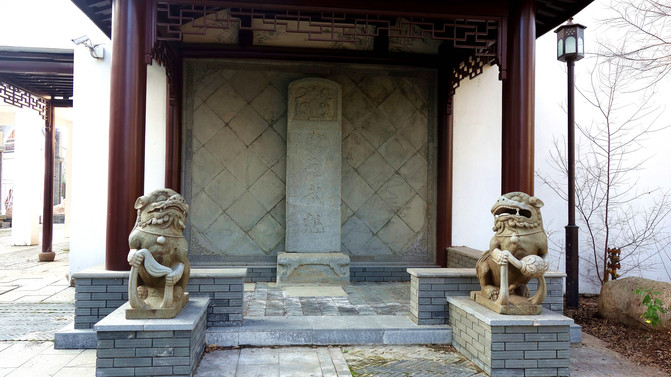
This ugly and cute guy called "White Male Fox" can be seen everywhere on the old street. It is said that the old street can be safe and prosperous only with its protection.

This building is still eye-catching in the old street full of surprises. This Yucun Art Museum is a perfect match of "ancient" and "foreign"
It makes people unconsciously intoxicated by the white walls and tiles.

A B & B built along the river is also a mix of Chinese and Western styles.

The Academy of Chinese Studies is deeply loved by parents today. When parents like it, children come.

On the side facade under the chevron eaves, a LOGO of "sitting and forgetting the study" hangs on the narrow wooden window lattice, which is very eye-catching.

There is a large courtyard in front of the study room. The courtyard is paved with cobblestones, with a few parasols, a few tables, a few chairs, and the warm sunshine in winter.

Sitting around the table was a family traveling, basking in the warm winter sun, and chatting softly.

Perhaps because it was winter, there was no one in the study. What everyone likes better in winter is the sunshine outside the house.

Beneath this traditional Jiangnan building with flying eaves and crooked corners is a literary and bourgeois coffee shop-simplifying the complex.

This small courtyard full of sunshine, the exquisitely transparent glass house full of sunshine has a nice name-"Suge Time". The owner must have gone home for the New Year. The door was locked, but it couldn't lock in the warmth that could be seen through it.

Take a look at the charm of the strong Soviet-style gardens along the Xietang River! Compared with the enclosed gardens in the city, the Soviet-style gardens here are a bit more atmospheric and rough.


Small bridges, running water, and people can be seen everywhere here, from cities to residential buildings, from neighborhoods to gardens, from gardens to hearts.

The various elements of Suzhou gardens are extremely reflected here. There are scenery everywhere, and a picture can be formed with a casual pat. The simple lines reflect the small details of Soviet-style life everywhere.




A four-corner pavilion-Yicui Pavilion-is built in the spacious place. The pavilion is like a dragon head, and behind it is a long and winding corridor. The long stone bench under the shed corridor can be rested. Because it has the functions of rain-proof, sunshade and leisure, it is often a place where citizens gather.

On the white jade bridge deck, there is a covered bridge with red columns and high eaves. The red lanterns are tall, which protects the wind and rain, and is beautiful and vivid.


The white walls and red window lattices, especially the two layers of blue herringbone eaves that overlap each other, are like a pair of lovers who are glued to each other. In the foreground are elegant pavilions, pavilions, bridges and flowing water. The back view is towering modern buildings. This kind of mix and match is also harmonious.



The little monk basking in the sun on the bridge railing is so comfortable. Was he intoxicated by everything in front of him, or was his heart melted by the warm winter sun?

This is the renovated Xietang Old Street. It organically integrates traditional humanities and modern commerce through antique buildings, Soviet-style gardens, and leisure formats. It still becomes a fashionable and leisure district integrating catering, shopping, entertainment, culture and other functions.

Call it fashionable, but it also has a trace of an old street. Although it is a renovation and reconstruction, the historical charm still remains. The old street is a perfect combination of tradition and modernity, and classics and fashion go hand in hand. In the city full of high-rise buildings, the cultural heritage of Suzhou in the past and the unique humanistic feelings of the Jiangnan water town are still preserved. If you go to Shantang Street and Pingjiang Road, if you still have half a day, you can come here to experience the Xietang that is different from those two streets.

Five. Jinji Lake
We left Suzhou on the high-speed train at night, so we wanted to find a downtown area to stroll around, have dinner and then return home. So I chose Jinji Lake Commercial District. Xietang Old Street is located at the branch of Jinji Lake, but when I opened the map and saw that the huge Jinji Lake was surrounded by unique business districts. It was almost impossible to walk to Jinji Lake. The Jinji Lake landscape is divided into eight large areas: Hubin Avenue, City Square, Shuixiang Neighborhood, Wanghu Corner, Peach Blossom Island... Different regions and different themes must bring us different feelings. Because there was no homework done beforehand and there was no clear destination. You can only choose the direction closer to the subway station. The destination for Didi's taxi is Hubin Park. Leaving Xietang Old Street, cars basically drive along Jinji Lake. The lake is open, and the blue sky and the blue color of the lake are integrated. Along the way, the urban scenery and natural scenery on the lake bank blend in series. It is a modern and international beauty that is different from the beauty of the ancient city of Suzhou with small bridges and flowing water. The car drove past Ligong Causeway and found that it was a courtyard-style garden layout with pink walls and black tiles on clear water and white waves. Various forms of antique covered bridges and stone bridges connect the lake and the lake to create the charm of the water town. Remember this, I will come and sit next time.
The car is parked in Lakeside Park. When you get off the bus, you can see the green lawn in early spring, not far away is the open lake, and further away is the east bank of Jinji Lake with many high-rise buildings.

Looking east across the lake is the Suzhou Science and Technology Center and the landmark building-the Ferris Wheel.

The Jinji Lake Bridge across the lake connects the west and east of the lake.

The beautiful scenery and majestic Jinji Lake subverts the impression that Suzhou has given us in the past few days of being a small family. It turns out that Suzhou also has a beautiful side.
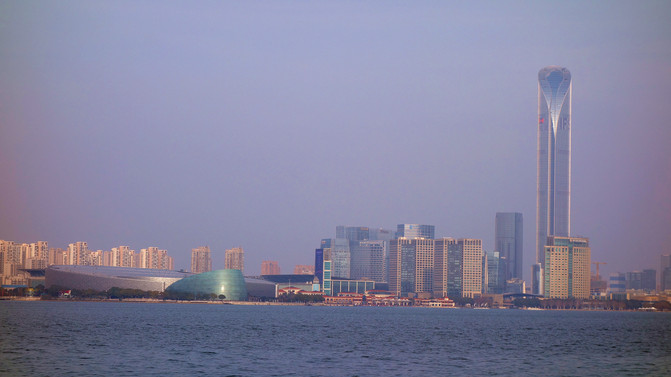
Walking towards the lake and facing the scenery in front of him, what thoughts did the young man have?
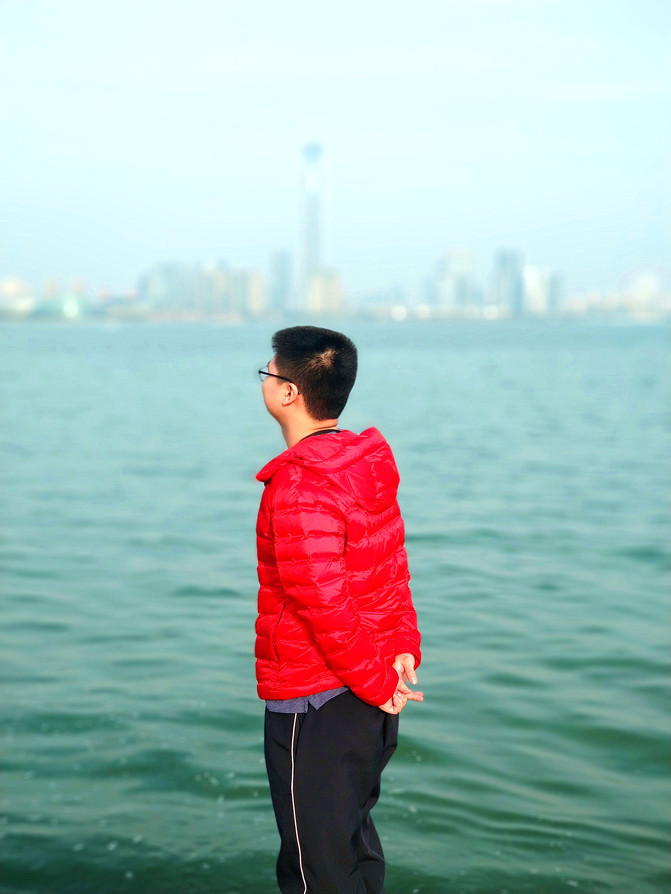
Hubin Avenue is on the west bank of Jinji Lake and is a scenic avenue for citizens to stroll. On one side is the rippling light of Jinji Lake, and on the other side is the modern urban landscape. Blue sky and white clouds under the lake, the blue Jinji Lake and the happy people on the bank of the lake constitute a beautiful picture of urban life.

The avenue is like a rhythmic landscape. The square by the lakeside is a place for citizens to play. Here, men, women and children can find their own favorite leisure ways.




harmonious picture



Cinnamomum trees are lined up along Hubin Avenue.
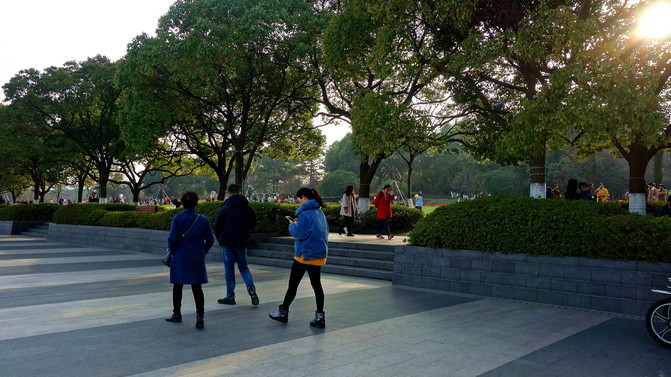
Many themed sculptures in Lakeside Park are lifelike.

It has a unique landscape and is full of modern leisure and sightseeing options. You can walk and ride here. Come to Jinji Lake for a weekend and experience the ever-changing charm of Jinji Lake.

The Ancient City of Suzhou where we walked two days ago has strong ancient elements of Suzhou-small bridges, flowing water, people, Wu language... Then here brings us the modern elements of the modern Suzhou Industrial Park-lake water, sculpture, square, rhythm...

Looking up at the "Big Pants" not far from the square is the Eastern Gate nicknamed the "Autumn Pants Tower".

Cross Xinggang Street and approach the Eastern Gate.

Cute little pink pigs are waiting at the entrance of the tourist center.

Buildings of various shapes and sizes crowded around.

Trees of various shapes are dotted on the connecting bridge like works of art.

The silhouette of the Eastern Gate

Because of the projection effect of the glass curtain wall in the building, there is one in you and one in me.


I looked so small under the scattered buildings. Compared with Suzhou in the past two days, this place is young, modern, dynamic and passionate. It displays a complete fashion look. A beautiful city must be ever-changing.

Modernist art sculptures dot it.
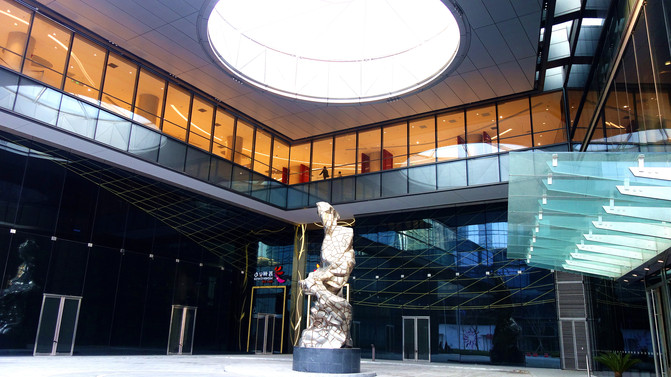

The people in this huge commercial complex move rapidly. Looking at these people coming and going in a hurry, I feel a little puzzled. What are they chasing?

I wanted to take a nap in Haagen-Dazs and look at the crowd standing and waiting, but I gave up the idea. We found a gourmet shop on the ground floor and found a place where we didn't have to wait for a waiting table to fill our stomachs to catch the high-speed train.

Walking out of this huge commercial center and looking back at the exterior, this is a beautiful building shaped like a sea shell-Suzhou Center.

The lanterns on Jinji Lake are first put on, and the flowing lights are beautiful, like a new star complementing the ancient city of Suzhou, turning Suzhou into a modern city of ancient charm.

It is a quick subway ride from Jinji Lake to Suzhou Station. The lights on the square in front of the station flashed.

I have been to Suzhou several times on and off over the past few decades, but every time I have new scenery, new discoveries, and new perceptions in my heart. During this trip, I have visited those gardens many times. Dushu Lake and Jinji Lake are the first time I have visited them. Whether they are familiar or unfamiliar, they will have new perceptions. I hurried into other people's cities, watched unknown or known scenery along the way, and left in a hurry, but I knew that I would see you again in Suzhou.


Previous Article:Drinking from the Ming Dynasty to the present, 31 thousand pots of wine are enough to comfort the world
